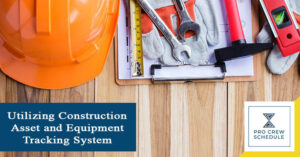Inventory is one of the main cost drivers in any business industry. The cost for inventory stocks alone accounts for half, or maybe even more, of the project’s total budget allocation in the construction industry. So as a project manager, inventory management is often one of the responsibilities you have to prepare for when managing construction projects. Even if you are starting your career as a project manager or have years of management experience up in your sleeve, inventory management may still be an overwhelming process – especially if you handle multiple projects simultaneously. In this case, the demand for more materials and resources also increases. Tracking each inventory stock, knowing its status and locations, and efficiently allocating it to suitable activities is a very challenging task in itself. You may find yourself struggling to deal with making sure that you still have enough of your stock on-site and with managing supplier lead times.
However, inventory management does not have to be so complicated. With all the complex processes and tasks involved with tracking your inventory, it simply boils down to how you can effectively balance the number of inventory stocks going in and out of your project site. A good construction inventory management system allows you to make sound business decisions based on the available information, thus maximizing your company’s profitability.
The next question that is probably running through your mind would be – how can we effectively execute a sound inventory management system? In this blog, we will dive in on understanding the connection between inventory management and profitability and share how the use of web-based inventory software can help you elevate your profitability. To start, we will determine what inventory and profitability are.
What is Inventory?
A construction inventory list refers to a detailed list of all stocks – material, tools, parts, and equipment, available in a specific location within a particular timeframe. Two types of inventories can be seen in a construction project, namely direct and indirect inventories.
Direct Inventory
Direct inventory refers to all materials or resources directly used in producing a building or a structure and is essential in its completion. Direct inventory can be further divided into three subcategories.
1. Raw Materials
Raw materials are items that a contractor buys directly from suppliers and converts the materials to Work-In-Progress Goods or Finished Goods. For example, raw materials in construction would include the following:
- Cement
- Sand
- Aggregates
- Reinforcing Steel Bars
- Bricks, Concrete Hollow Blocks
2. Work-In-Progress (WIP) Goods
Work-In-Progress (WIP) Goods are raw materials taken out of storage and need to be converted into something else. An example of these would be the fabrication of steel bars, shaping them into the proper specifications before installing them on-site.
3. Finished Goods
Finished goods are goods that may come directly from the supplier and can be readily used on-site. Usually, these are for the finishing stages of the project – water closets, sink fixtures, a window, or a door are a few examples of finished goods.
Indirect Inventory
Indirect inventory is used to complete a task or an activity but is not part of the raw materials. Indirect inventory in construction may include the following:
- Tools, Heavy Equipment, and Machinery
- Consumables, such as nails, wires, and screws
- Administrative Items such as Construction Inventory App or RFID Systems
What is Profitability?
Profitability is a measure of how a company maintains its profit margins against the size of the business. It is defined by how a company is efficient when running a project from start to finish. When it comes to project management for construction, profitability also determines if a contractor’s performance in a project can be considered a success or not. Although a contractor can profit from a specific project, it does not necessarily mean profitable. Thus, a project manager should always aim to stick within the allotted budget, avoid delays, finish and deliver the project on time – without maintaining a high level of quality and performance.
Understanding the Connection Between Inventory Management and Profitability
Now that we have defined inventory and profitability, we will be discussing how inventory management can affect your profitability in this section. As we have discussed earlier, a project’s inventory is one of the primary sources of expenses in construction. And as we aim to elevate your company’s profitability, one way to do so is by keeping cost levels low through the implementation of optimized inventory management in construction projects.
For us to have a clear perception of the connection between good inventory management and a company’s profitability, think of it this way. Imagine that your direct and indirect inventories are money, wherein each unit is equivalent to a specific amount in your budget and cost allocation. With those in mind, let us define the effects of inventory mismanagement – having insufficient inventory or stockouts and having overstocks.
Effects of Having Insufficient Inventory or Stockouts
Having insufficient inventory or stockouts often leads to more delays and potential losses. In construction, having too little inventory means work activities will progress slower, resulting in delays in the schedule. A stockout, on the other hand, may result in a work stoppage entirely. With that, worker and project productivity will significantly decrease – especially if the items are subject to supplier lead times.
Effects of Having Overstocks
Overstocks are a surplus of materials on-site, leaving the contractor with many unwanted materials once the project is finished. Effective inventory management helps you forecast the resources you need for a specific activity, preventing potential budget deficits.
1. Tied-Up Budget
Inventory can also be considered allocated cash – tied-up money invested in the project but cannot be returned or refunded. If you have stocks just sitting on your storage shelves, you cannot reallocate the budget to areas where it may be urgently needed – wages, rent, or other overhead costs.
2. Liquidity
Inventory is a lot less liquid than cash – and investing too much of it into raw materials, WIP goods, or finished goods can seriously put a dent into your company’s cash flow. Contractors often work with a progress billing setup, so strategically allocating budgets is essential to prevent delays in the project.
3. Warehouse Costs
Storing excess inventory entails additional costs, such as renting out a more extensive warehouse or adding other personnel to manage the storage locations. Overstocks often take up space within your storage for a longer time and get in the way of the warehouse flow.
Finding the Balance between Stockouts And Overstocks
Implementing an effective inventory management system helps you find the balance between having too few stocks and having too much of them. Proper management can help you save time and money, all while living up to your client’s expectations. By having accurate information, you can forecast the stocks when you need them and incorporate these dates with your supplier lead times to ensure that the products are delivered on time.
Even in the present times, contractors often stick to the traditional and laborious way of monitoring inventory – either through manual monitoring lists or through the dozens of spreadsheets. However, with the rapid digitalization of the construction industry, utilizing inventory management software has proven to increase efficiency in monitoring your stocks accurately. We have listed down a few software features you should consider when it comes to choosing the right software for your project:
1. Centralized Inventory Control
Construction inventory software allows your team to access real-time data updates and track inventory status easily by simply logging onto the cloud. With this, everyone can have a clear end-to-end view of the progress, from purchase requisitions, purchase orders and delivery.
2. Automated Inventory Tracking
With the rising modernization of the world, construction software aims to reduce all manual and repetitive tasks and turn them into automated tasks to eliminate human error and inefficiencies. Tracking deliveries, organizing material codes and quantities, and monitoring inventory usage is now made more accessible, ensuring that all data is up-to-date to prevent miscommunications and inventory mismanagement.
3. Detailed Inventory Information
Inventory software can handle vast amounts of relevant data. It can convert these data into trend analysis that can help you improve your resource forecasting – enabling you to determine when you should order a particular item or look for alternatives. These data can also help you make sound, data-driven business decisions and ensure that your inventory will never experience having stockouts or overstocks.
Key Takeaway
Inventory comprises a massive chunk out of your budget allocation in especially in construction projects. Thus, inventory management plays a significant role in determining your company’s profitability. Inventory management may seem tedious and challenging, but it does not have to be so complicated. Instead, it is all about finding the right balance between having little to no stocks and having too much of it. Having the proper inventory helps you be efficient in your project, ensuring that the work processes keep flowing and productivity is maintained or increased throughout the project.
Upgrade your inventory management system with Pro Crew Schedule, a construction scheduling software that can help you streamline and automate manual tasks – making construction more manageable and more efficient than ever.







